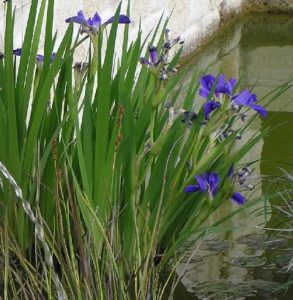
Iris virginica
Non-Herbicide Management Options
1. Physical Management Options
Blue flag can be cut and the rhizomes can be dug up, but physical control is difficult.
2. Biological Management Options
There is no known biological control for blue flag; although goats are known to forage on many types of emergent vegetation.
Herbicide Control Options
Always read the product label for directions and precautions, as the label is the law. Click on the name of the product to see the label. Read the label for specific water use restrictions.
The active ingredients that have been successful in treating blue flag include:
- Diquat (Rated: Good)
- Glyphosate (Rated: Excellent)
These ratings are based upon the U.S. Army Corps of Engineers aquatic herbicide trials.
1) Diquat:
Diquat is a contact algaecide and herbicide. Contact herbicides act quickly and kill all plant cells they come in contact with.
Common trade or product names include but are not limited to:
2) Glyphosate
Liquid glyphosate formulations have been effective on blue flag above the water line, but ineffective on plants in the water. They are broad spectrum, systemic herbicides. Systemic herbicides are absorbed and move within the plant to the site of action. Systemic herbicides tend to act more slowly than contact herbicides. An aquatically registered surfactant (see the label) will have to be added to the glyphosate solution for good results.
Common trade or product names include but are not limited to:
Precautions
One danger with any chemical control method is the chance of an oxygen depletion after the treatment caused by the decomposition of the dead plant material. Oxygen depletion can kill fish in the pond. If the pond is heavily infested with weeds, it may be possible (depending on the herbicide chosen) to treat the pond in sections and let each section decompose for about two weeks before treating another section. Aeration, particularly at night, for several days after treatment may help control the oxygen depletion.
One common problem in using aquatic herbicides is determining area and/or volume of the pond or area to be treated. To assist you with these determinations see SRAC #103 Calculating Area and Volume of Ponds and Tanks.
Many aquatically registered herbicides have water use restrictions (See General Water Use Restrictions).
To see the labels for these products click on the name. Always read and follow all label directions. Check label for specific water use restrictions.
Cultivation Options
Blue flag can be propagated by transplanting whole plants with rhizomes into moist soil. Plants can be divided in early fall when the leaves begin to turn yellow. Stringy roots should be kept attached to rhizome sections. If you plan to propagate by seed, plant immediately. Storing seeds reduces viability
Questions?
If you need assistance, contact the Ag & Natural Resources agent in your county or hire a professional.